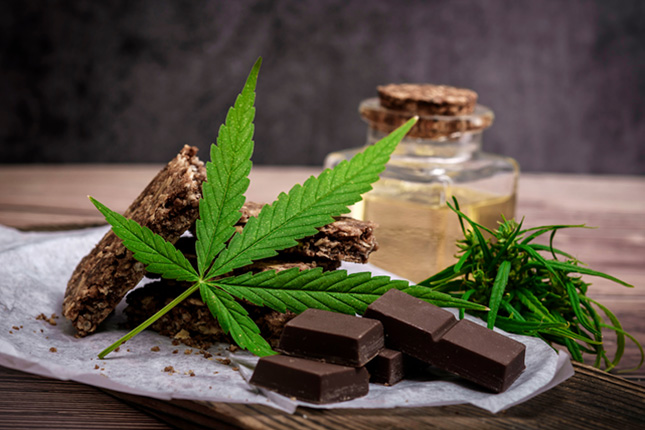Knowledge Base
WHAT TO KNOW ABOUT CANNABIS
Cannabis is made up of many components, which are known as cannabinoids. Cannabidiol (CBD) and tetrahydrocannabinol (THC), are the two most well-known and researched cannabinoids. THC is responsible for the “high” that many people associate with cannabis, while CBD is a non-intoxicating, non-euphoric component, which you may have seen in the form of oils, gummies, drinks, and other products for medical purposes.

HOW CAN CBD BE USED TO BENEFIT HEALTH?
While researchers are still working to understand how effectively CBD can be used for medical purposes, there have already been a lot of promising results. Here are seven ways that CBD has been proven to benefit health:

A study conducted by JCI Insight in 2017 found that CBD lowered the blood pressure of human participants. It reduced their resting blood pressure as well as their blood pressure after stress tests including mental arithmetic, isometric exercise, and the cold pressor test.
CBD has been proven to help reduce inflammation and the neuropathic pain it can cause, according to a study by the Rockefeller Institute of Medical Research.
A 2018 study discovered that CBD can be useful in helping people who suffer from drug and alcohol addiction. A preclinical trial with lab rats determined that CBD reduced the stress-induced cravings, anxiety, and lack of impulse control that often cause people to relapse.
Anxiety is perhaps the most common affliction that people have used CBD for, and a preclinical study found that CBD could be effective in treating generalized anxiety disorder, panic disorder, social anxiety disorder, obsessive-compulsive disorder, and post-traumatic stress disorder.
A recent study found that CBD and other non-psychoactive cannabinoids can effectively be used to prevent and treat GI disorders such as irritable bowel syndrome (IBS), inflammatory bowel disease (IBD), Crohn’s, ulcerative colitis, and more. CBD’s anti-inflammatory properties are key to reducing and preventing symptoms.
Decades of research have gone into using CBD to treat epilepsy and other seizure syndromes, and a recent study showed it can have positive effects in reducing symptoms and seizure frequency.
WHAT TO CONSIDER?
STRAINS
Sativa and Indica are the two main types of cannabis used for a number of medicinal and recreational purposes.
- SATIVAS (known for their “head high”) provide an invigorating, energizing effect that can help reduce anxiety or stress and increase creativity and focus.
- INDICAS (typically associated with full-body effects) provide increasing deep relaxation and reducing insomnia.
Cannabis plants contain dozens of chemical compounds called cannabinoids. These naturally occurring components are responsible for producing many of the effects of cannabis.
Two main ones — tetrahydrocannabinol (THC) and cannabidiol (CBD)
- THC is the main psychoactive compound in cannabis plants. It’s responsible for the “high” or state of the euphoria associated with cannabis use. Levels of THC have been increasing as growers try to create hybrids with a greater concentration of the compound.
- CBD is non-impairing or non-euphoric. It doesn’t cause a “high.” However, it may produce many physical benefits, such as reducing pain and nausea, preventing seizures, and easing migraine.

SATIVAS
- Typically have lower doses of CBD and higher doses of THC.
- Often produces a “mind high,” or an energizing, anxiety-reducing effect. If you use sativa-dominant strains, you may feel productive and creative, not relaxed and lethargic.
- Because of its stimulating impact, you can use sativa in the daytime.

INDICAS
- Typically have higher levels of CBD, but the THC content isn’t necessarily less.
- Sought after for its intensely relaxing effects. It may also help reduce nausea and pain, and increase appetite.
- Because of its deep relaxation effects, indica is better consumed at night.

HYBRID
- Many hybrid cannabis plants are grown in order to increase the THC percentage,
but each type has a unique ratio of the two cannabinoids. - Producers select hybrids for their unique impacts. They can range from reducing
anxiety and stress to easing symptoms of chemotherapy or radiation. - Daytime or nighttime use depends on the predominant effects of the hybrid.
WHAT TO REMEMBER?
When you’re looking for the right cannabis product for you, keep these considerations in mind:

KNOW WHAT YOU’RE TRYING TO ACHIEVE
What you’re trying to feel or treat will help you narrow your options. Talk with the dispensary employee about your goals for cannabis use, whether that’s treating insomnia, reducing anxiety, or increasing energy.
UNDERSTAND YOUR TOLERANCE
Some strains, such as Pineapple Express, are considered “entry level.” Their effects are typically mild and tolerable. Strains with higher levels of cannabinoids may be too potent for a first-time user.


CONSIDER YOUR MEDICAL HISTORY
While cannabis is a natural product, it can cause intense effects. Before you try cannabis, you need to consider possible interactions with existing medical conditions and medications. When in doubt, ask a doctor or other healthcare professional about your individual benefits and potential risks.
DECIDE ON A DESIRED CONSUMPTION METHOD
Each technique for consuming cannabis has benefits and drawbacks. If you smoke or vape cannabis, you may feel effects more quickly, but it can irritate your lungs and airways. Gummies, chewables, and foods may be easier to tolerate, but the effects take longer, and they may be much more potent than inhalation.

